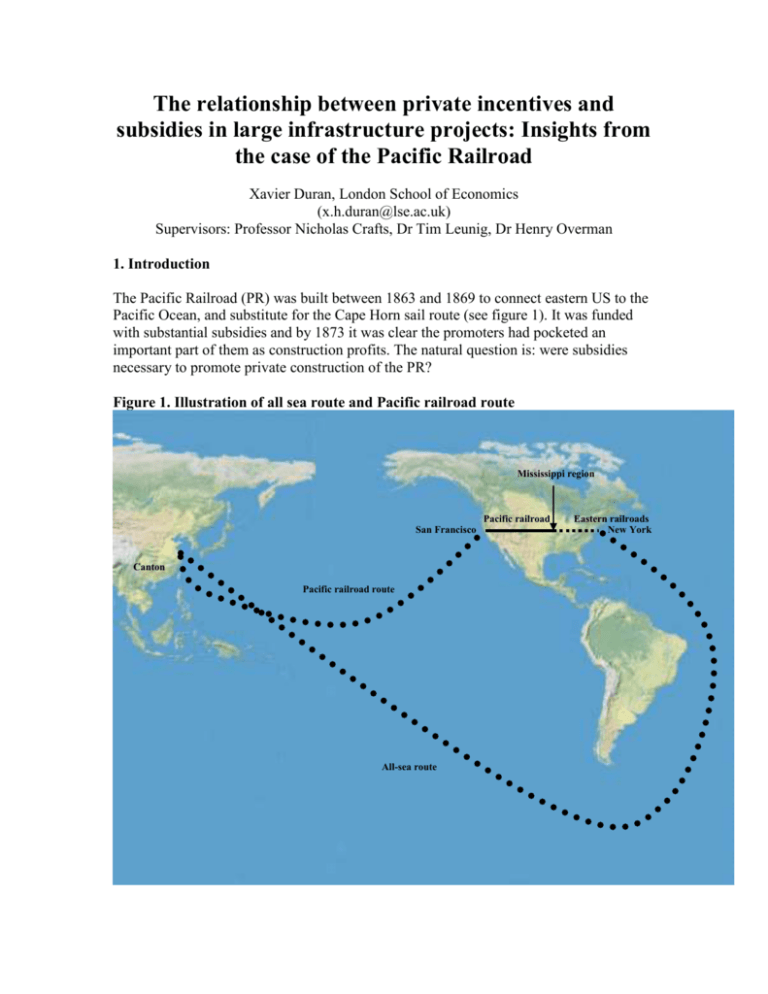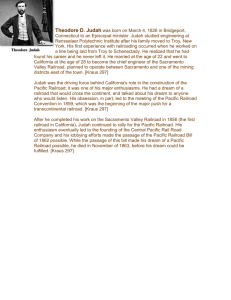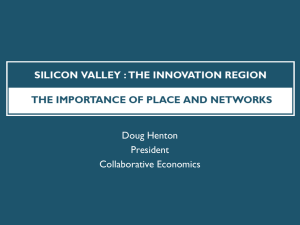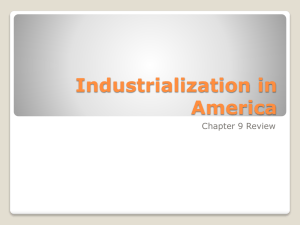The relationship between private incentives and subsidies in large
advertisement

The relationship between private incentives and subsidies in large infrastructure projects: Insights from the case of the Pacific Railroad Xavier Duran, London School of Economics (x.h.duran@lse.ac.uk) Supervisors: Professor Nicholas Crafts, Dr Tim Leunig, Dr Henry Overman 1. Introduction The Pacific Railroad (PR) was built between 1863 and 1869 to connect eastern US to the Pacific Ocean, and substitute for the Cape Horn sail route (see figure 1). It was funded with substantial subsidies and by 1873 it was clear the promoters had pocketed an important part of them as construction profits. The natural question is: were subsidies necessary to promote private construction of the PR? Figure 1. Illustration of all sea route and Pacific railroad route Mississippi region Pacific railroad San Francisco Canton Pacific railroad route All-sea route Eastern railroads New York The question has been subject to heated debates continually. The entrepreneurs pursuing the project had to go to Congress for approval since the railroad was to cross federal territories. Congressional debates started in 1845 when the first project was submitted and because of the subsidies and the corruption scandals have continued since then1. Existing academic literature has adopted an ex-post qualitative or cost-benefit (social savings) approach to answer this question. Business historians suggest the difficulty and heroic nature of the entrepreneur’s work surely deserved subsidies2. Economic historians suggest the PR was not expected to be profitable, but surprisingly turned out to be high profitable, privately and socially3. Not only national and academic debates still exist, but the question is certainly not a trivial one. The issue is about how to distinguish between asymmetric information and uncertainty, given our limited ability to predict the future, and the role for private and public interests in the development of large infrastructure projects. The standard approach to evaluate these projects is to apply cost-benefit analysis to measure private and social benefits of the project once it has been built (ex-post). The thesis presented here argues that analysing this question with only ex-post information is not satisfactory. A key issue is whether the project was expected to be privately profitable or not. In order to develop the ex-ante approach, two sets of information are compared: 1) expectations as declared by entrepreneurs before subsidies were provided, and 2) “expectations” as derived from a counterfactual model of the entrepreneurial decision controlling for any incentives to lie the entrepreneurs might have faced. The purpose of the comparison is to distinguish between asymmetric information and uncertainty. The view resulting from pursuing this approach is radically different to existing literature. First, entrepreneur’s reports indicate that technological uncertainty had been greatly overcome before the subsidies had been granted. Second, the expectations declared by the entrepreneurs and the simulated outcomes suggest the PR was and should have been expected to be profitable. Thus, subsidies were not needed to promote private construction of the PR. Moreover, the essence of profit expectations was the possibility of the PR capturing rents associated to the provision of new goods (reduced travel time and safety), an angle entirely overlooked by the existing literature. The next section of the paper presents and discusses the expectations as declared by the entrepreneurs, followed by a section discussing the main findings derived from the counterfactual model. Finally, conclusions are put forward. 2. Expectations as declared by entrepreneurs in their project reports The information on entrepreneurial expectations comes from private and public reports developed by entrepreneurs promoting and building the PR, 1845-1869. The reports had been previously overlooked and allow identifying clearly profit expectations, as declared by entrepreneurs4. 1 See headlines of New York Sun, Sep. 4, 1872 and Newsweek, Sep. 16 1972, p. 35. See Duran (2007) for a review. 3 See Duran (2007) for a review. Particularly important is Fogel (1960). 4 Business historians acknowledge the existence of the reports but did not analyse the information contained in them. Economic historians do not acknowledge the existence of these reports. 2 The first entrepreneur to draw a project to build the PR was Asa Whitney, a merchant that had been active in New York, London and China and was connected to the Jay family. In 1845, after returning from China, he submitted to Congress the first of several memorials proposing a plan to build the PR. The most detailed of his documents indicated that the main objective for construction of the Pacific railroad was to divert the Europe/US-Asia trade that went through Cape Horn and Cape of Good Hope (Whitney, 1849). Using trade statistics he identified the magnitude of market size for the PR. Additionally, he also worked out that travel distance and time would be reduced by 50% compared to the all-sea route. Whitney also requested Congress to provide the railroad company with land grants. In turn, land granted would be sold to fund the PR’s construction. The railroad should price close to operational costs to allow for maximum trade diversion and maximising the benefits for the US5. Asa Whitney promoted the project in Congress for seven years, but was not successful. Although he achieved to convince the nation of the benefits of the PR, he was probably too successful. Entrepreneurs and politicians realised the potential of the project’s idea and developed competing projects. When retiring, Whitney indicated that inter-regional conflicts of interests over the benefits of the PR blocked his project6. Searching for a technical choice, in 1853 Congress decided to request the army to evaluate different alternative routes for the railroad and estimate their costs. The second influential entrepreneurs was Theodore Judah, a New York railroad engineer who had worked on the construction of Niagara Falls Gorge railroad, an engineering feat of the time, and the construction and operation of other large transport projects. In 1854 he moved to California to build the Sacramento Valley railroad, originally envisioned as a local railroad that would grow into the PR. Judah surveyed the area, developed PR project proposals, and also went to Congress to promote them, although unsuccessfully. The pass over the Sierra Nevada was the major technical difficulty on the PR route. In 1859 Judah found a pass that implied technical difficulties comparable to those found in the eastern railroads. The existence of the pass reduced technical uncertainty substantially. Additionally, he managed to convince a group of Sacramento merchants to fund the exploratory activities that led to the development of a series of reports between 1860 and 1862. In these reports Judah showed that it was possible to build the railroad without using grades steeper than those of eastern railroads, and provided all the project details (route, grades, curves, bridges, tunnels, costs and expected earnings). In summary, Judah’s reports indicate the railroad route had been identified to a high level of detail, it would not imply operating conditions more complicated than those experienced by eastern railroads, high profits were expected and requested subsidies (with no explicit justification). After the reports were written, Judah went to Washington to pursue the project late in 1861. In Washington Judah achieved to pass the project all the way through Congress. In 1862 President Lincoln signed the Pacific Railroad Act dividing the route 5 Note that Asa Whitney implied the PR was expected to be profitable, but it was not desirable for the US that the PR charged commercial rates. 6 Also note the geography of the conflict over the gains and costs of the Pacific railroad neatly coincides with that of slavery, complicating further the political economy of the project. between the Central Pacific and the Union Pacific railroads and granting subsidies in the form of land grants and a loan of treasury bonds. Finally, the third entrepreneur was General Grenville Dodge. Already before the Civil War Dodge was a well connected railroad engineer, and held a meeting with Abraham Lincoln to discuss the route of the PR over the plains of what is today Nebraska and Wyoming. When the war was finishing, Dodge joined the Union Pacific as chief engineer. An investment prospectus published in 1868 indicates the Union Pacific was expected to be profitable, international and inter-regional US trade and passenger traffic was expected to generate most profits, and proposed prices would be higher than prices observed on competing all-sea routes as safety and time savings brought by the rail route would be valued by part of the traffic. Subsidies had already been granted and used. Summarising, the proposals by the three most persistent entrepreneurs indicate i) detailed information for most of the route that was actually built existed by 1861 and ii) the PR was expected to be profitable. Moreover, the fact that a diverse group of entrepreneurs were pushing for i) five other different transcontinental railroad routes within the US, ii) another transcontinental railroad route through Canada, iii) Canals though Central America and the Suez, and iv) invested in the development of the Clipper ships to bring luxury perishable goods from Asia, are all an indication of profit expectations derived from the Asia trade. Expectations declaring profitability would normally indicate no need for subsidies. Although the existence of technical uncertainty cannot be fully discarded as the PR clearly implied work in a scale never performed before, efforts to overcome uncertainty had been performed successfully. The most difficult tasks had been identified, studied and their costs evaluated. Additionally, the construction period evidence indicates most of the road was actually built over the route identified by 1861, the difficult tasks had been correctly identified, and modern engineers think it was not possible to improve the choice of the route. Alternative measures of risk, like difficulties selling PR company bonds, do not allow to directly asses investor belief over technical uncertainty in a context of i) economic uncertainty and short run profits - the Civil war, ii) important price distortions due to post-war booms (1868-72), and iii) general distrust over those controlling both companies - as indications of the corruption scandal had already been brought to the public by the press during construction. Finally, it is also necessary to acknowledge and consider carefully why entrepreneurs might have declared the PR to be profitable and also requested subsidies. It is certainly not obvious why they behaved in such a way, but it clearly points out the existence of incentives to lie by the entrepreneurs. Entrepreneurs had incentives to underestimate private profits and regional costs and overestimate national gains when in Congress to obtain the right of way. When approaching capitalists, they had incentives to overestimate private profits. 3. “Expectations” as derived from a counterfactual model controlling for the entrepreneurs incentives to lie In an attempt to study the entrepreneurial decision while also controlling for the potential biases entrepreneur’s declarations may imply, a counterfactual model was developed. The model studies the entrepreneurial decision whether to build or not the PR taking into account exclusively purely transport market incentives and assuming that entrepreneurs could buy the right of way for a fixed fee and can get all the funding they needed from the capital market. The model’s behavioural assumptions are based on the approach developed by the entrepreneurs to frame the construction decision, as evidenced by their documents. Entrepreneurs used to infer demand for the PR by identifying initially observed traffic and prices with the existing transport modes and then, using the intuition behind the concept of the elasticity of demand, to reason how traffic levels would change as transport price (i.e. the PR price) increased or declined7. Finally, entrepreneurs also indicated expected construction and operation costs. Thus, it is possible to use the entrepreneur’s reports to derive a simple model of entry into the transport market for the PR8. The parameters of the model were derived from information sources used by the entrepreneurs and publicly available before 1861, to conform to the ex-ante approach of the paper9. The results of the simulation model indicate several findings. First, if the observed transport price is taken as a ceiling price, the PR should not have been expected to be profitable as sea transport had substantial cost advantage over rail. Second, entrepreneurs were aware the PR would provide new good benefits. Travel time and safety would be dramatically reduced by the introduction of the PR, particularly for eastern-western US freight and passenger traffic. If entrepreneurs priced PR rates to capture rents derived from these new good benefits (as some declared they would), and if these benefits were proportional to what had been observed for small time and safety savings achieved during the 1850s, then the PR should have been expected to be profitable. Third, the comparison between declared expectations and the simulation outcomes revealed a key information advantage for entrepreneurs. Judah implicitly assumed an elastic demand and explicitly proposed the PR should reduce prices. Dodge implicitly assumed an inelastic demand and explicitly proposed to increase prices. Note that both behaviours are credible profit maximising outcomes (in the sense of game theory equilibrium concepts) given the implicit assumption about the elasticity of demand in each case. Moreover, not only both behaviours were credible, but it was difficult to identify in the entrepreneur’s reports the implicit elasticity value and it was even more difficult to dispute it. Only when the whole simulation exercise was performed it became apparent that the scenario suggested by Judah was simply not feasible. Table 1. Summary simulation outcomes Pricing policy Maximum pricing equivalent to all sea route observed price Pricing to capture rents from new good benefits 7 Net earnings per year/construction cost NPV Construction cost/Net earnings per year -25.1 7.8 12.8 9.5 16.6 6.0 Judah (1862) pp. 51-52. Note it is only argued that entrepreneurs knew about the intuition behind the elasticity of demand, not that they called it elasticity, not that they would calculate it in the same way we do today, or that they would derive it in same way we do today. 8 The full model is presented and discussed in detail in Duran (2008). 9 The full details of the parameters used may be found in Duran (2008). 4. Conclusions Private and public documents written by the three most persistent entrepreneurs promoting construction of the PR were examined. The documents indicate clearly that the entrepreneurs performed substantial and successful efforts to overcome technical and economic uncertainty and they all expected the PR to be profitable. Additionally, the view proposed here also emphasised on two important issues overlooked by existing literature. First, the importance of new good benefits delivered by the PR and the potential for rents and profits they created. Second, the PR entrepreneurs were part of a wide group of entrepreneurs in different countries competing to profit from the Asia trade and proposing business projects using different technologies (railroads, canals, clipper ships) and routes. Thus, as technical and commercial uncertainty had been substantially overcome it is difficult to justify subsidies. Comparing declared expectations to simulated outcomes allowed highlighting the role of asymmetric information. It has been suggested that entrepreneurs enjoyed information advantages when choosing, implicitly, the elasticity of demand. Depending on the implicit value of the elasticity of demand they could propose a price reduction or a price increase as credible business strategies. Additionally, entrepreneurs initially declared to reduce prices when going to Congress to obtain the right of way. After the right of way had been granted, they went to the capital market to obtain private funding and proposed to increase prices. The simulation analysis performed, however, has revealed that the PR would have not been profitable if prices were decreased. Thus, entrepreneurial behaviour is consistent with opportunistic behaviour based on the possession of asymmetric information. Finally, more research is still required to understand better the allocation of subsidies. A normative explanation is not consistent with the evidence, as it has been shown above that uncertainty had been greatly reduced and capital markets during this period may be assumed to be large enough to fund any project in the US (Engerman, 1972). Alternatively, a positive explanation is required. Research presented here suggests that large scale projects tend to endogenously create distributional conflicts within Congress, as different groups compete to appropriate the benefits and avoid the costs of the project. Additionally, entrepreneurs must have had some bargaining power as they possessed key information on a socially beneficial project. Future research should look for social mechanisms that allow understanding i) the allocation of subsidies or ii) the delay of the diffusion of a large scale technology as two of the possible solution outcomes of an endogenous distributional conflict. References Cisco (1868) The Union Pacific. Duran (2007) Did entrepreneurs expect the Pacific railroad to be profitable? Duran (2008) Were entrepreneurs right to expect the Pacific railroad to be profitable? Engerman (1972) “Some Economic Issues Relating to Railroad Subsidies and the Evaluation of Land Grants” JEH, 32, 2, pp. 443-463 Fogel (1960) THE UNION PACIFIC RAILROAD: A CASE IN PREMATURE ENTERPRISE. John Hopkins University Press. Judah (1861) Report of the Chief Engineer. Judah (1862) Report of the Chief Engineer. Whitney (1849) Project for the Pacific Railroad.








